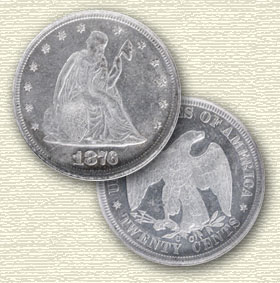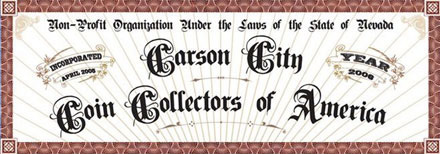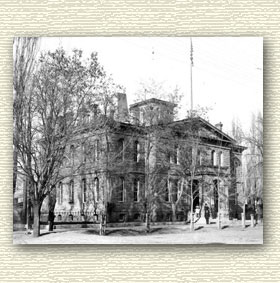1890-CC Morgan $1 CC Coin of the Week – 12-21-09
- blu62vette
- Topic Author
- Offline
- Banned
-

Less
More
15 years 11 months ago - 15 years 11 months ago #699
by blu62vette
1890-CC Morgan $1 CC Coin of the Week – 12-21-09 was created by blu62vette
1890-CC Morgan $1
On July 14, 1890 President Harrison signed the Sherman Silver Purchase Act replacing the Bland-Allison Act of 1878. This enabled the purchase of 54,000,000 ounces of silver per year and provided support for the price of silver. This silver purchased by the new issue of currency, Coin Notes, which were redeemable in gold and silver. Many of the Coin Notes were redeemed for Gold and help cause the Panic of 1893. In 1890 according to the Annual Report of the Director of the Mint costs of minting a coin in Carson City in 1890 was the most expensive of all mints at $.0816 per coin, with New Orleans being the cheapest at $.0183 and Philadelphia costing $.0215 per coin. There would be many factors influencing the high costs with a couple be the lower total mintage of coins effecting scalability and transportation costs.
The 1890 Carson City Morgan dollar has the highest mintage number of any CC Morgan dollar at 2,309,041. The strikes on these coins are considered average. There are many prooflike and deep mirror prooflike examples, though all issues tend to be baggy. Some strikes also note weakness the ear. It does seem that many of these strikes made it to circulation and may have been melted under the 1918 Pittman act. Examples above MS-64 become much more scarce, according to the PCGS population reports there are 254 examples higher than MS64 and 33 PL and DMPL examples in MS65 with none higher.
Looking at the 1890-CC on paper and it should have been destined for mediocrity. High mintage (relative for CC coins), average strike, what could make it stick out. Luckily someone stepped up to the plate and put a large gouge in the coin, creating the Tailbar. The Tailbar is a pronounced die gouge from the eagle’s tailfeathers to the wreath. The location of the gouge has earned it the tailbar name as the gouge looks like an extension of the eagle’s tailfeathers.
Personally I find a few items very intriguing about this coin and the gouge. This die was initially made with the gouge, it was not added during the minting process. The first coins struck with this die had the gouge. It can sure make one wonder how that slipped through and made it to the coin press. When it comes to the gouge itself I find the impression different than others. I don’t have the best knowledge of die makers tools but several other major gouges have grooves like the tool itself had lengthwise running grooves on it (Image of a 1880-O VAM 48 Hangnail can be found via the link at the end of this page for comparison). The Tailbar appears to be a smooth gouge but then shows evidence of two grooves on the upper end of the gouge in a depression like area.
When it comes to mintage and survival figures there are many different numbers floating around. There were 16 reverse dies available for striking but all may not have been used. He estimates between 144,000 and 237,000 1890-CC coins survive now. Surviving Tailbar numbers are hard to estimate but at the 3 major grading companies there have been 1206 graded with only around 25 PL and DMPL examples. An odd pop report note is that at PCGS the Tailbar population compared to the 1890-CC population has a ration of 1/16th. I welcome others to chime in with their estimates on surviving numbers.
Some Tailbar examples:
Between the crust on this coin you can see the Tailbar
Another example:
Large images of these examples and a couple more can be found here. Click on each image to go to a large image where you can see the grooves in the depression of the gouge.
Click here for images
On July 14, 1890 President Harrison signed the Sherman Silver Purchase Act replacing the Bland-Allison Act of 1878. This enabled the purchase of 54,000,000 ounces of silver per year and provided support for the price of silver. This silver purchased by the new issue of currency, Coin Notes, which were redeemable in gold and silver. Many of the Coin Notes were redeemed for Gold and help cause the Panic of 1893. In 1890 according to the Annual Report of the Director of the Mint costs of minting a coin in Carson City in 1890 was the most expensive of all mints at $.0816 per coin, with New Orleans being the cheapest at $.0183 and Philadelphia costing $.0215 per coin. There would be many factors influencing the high costs with a couple be the lower total mintage of coins effecting scalability and transportation costs.
The 1890 Carson City Morgan dollar has the highest mintage number of any CC Morgan dollar at 2,309,041. The strikes on these coins are considered average. There are many prooflike and deep mirror prooflike examples, though all issues tend to be baggy. Some strikes also note weakness the ear. It does seem that many of these strikes made it to circulation and may have been melted under the 1918 Pittman act. Examples above MS-64 become much more scarce, according to the PCGS population reports there are 254 examples higher than MS64 and 33 PL and DMPL examples in MS65 with none higher.
Looking at the 1890-CC on paper and it should have been destined for mediocrity. High mintage (relative for CC coins), average strike, what could make it stick out. Luckily someone stepped up to the plate and put a large gouge in the coin, creating the Tailbar. The Tailbar is a pronounced die gouge from the eagle’s tailfeathers to the wreath. The location of the gouge has earned it the tailbar name as the gouge looks like an extension of the eagle’s tailfeathers.
Personally I find a few items very intriguing about this coin and the gouge. This die was initially made with the gouge, it was not added during the minting process. The first coins struck with this die had the gouge. It can sure make one wonder how that slipped through and made it to the coin press. When it comes to the gouge itself I find the impression different than others. I don’t have the best knowledge of die makers tools but several other major gouges have grooves like the tool itself had lengthwise running grooves on it (Image of a 1880-O VAM 48 Hangnail can be found via the link at the end of this page for comparison). The Tailbar appears to be a smooth gouge but then shows evidence of two grooves on the upper end of the gouge in a depression like area.
When it comes to mintage and survival figures there are many different numbers floating around. There were 16 reverse dies available for striking but all may not have been used. He estimates between 144,000 and 237,000 1890-CC coins survive now. Surviving Tailbar numbers are hard to estimate but at the 3 major grading companies there have been 1206 graded with only around 25 PL and DMPL examples. An odd pop report note is that at PCGS the Tailbar population compared to the 1890-CC population has a ration of 1/16th. I welcome others to chime in with their estimates on surviving numbers.
Some Tailbar examples:
Between the crust on this coin you can see the Tailbar
Another example:
Large images of these examples and a couple more can be found here. Click on each image to go to a large image where you can see the grooves in the depression of the gouge.
Click here for images
Last edit: 15 years 11 months ago by Carsonite. Reason: Title
Please Log in to join the conversation.
- Decline Don
-

- Offline
- Banned
-

- I used to be Incline Don but I moved down the mt.
Less
More
- Posts: 35
- Thank you received: 0
15 years 11 months ago #705
by Decline Don
Replied by Decline Don on topic Re:1890-CC Morgan $1 CC Coin of the Week 12-20-09
Todd,
Congratulations on your first "Coin of the Week."
I am not a "VAM" person myself, but I enjoy the "tailbar" and "spitting eagle" varieties because you can see them with the naked eye.
Decline Don
Congratulations on your first "Coin of the Week."
I am not a "VAM" person myself, but I enjoy the "tailbar" and "spitting eagle" varieties because you can see them with the naked eye.
Decline Don
Please Log in to join the conversation.
15 years 11 months ago #706
by ccroger
Replied by ccroger on topic Re:1890-CC Morgan $1 CC Coin of the Week 12-20-09
I have to agree, I like vams I can see with the naked eye (or minimal help). The tailbar is one of my favorites.
Please Log in to join the conversation.
15 years 11 months ago #708
by Belayoff
C4OA Lifer!
Replied by Belayoff on topic Re:1890-CC Morgan $1 CC Coin of the Week – 12-21-09
Great job Todd and a perfect first posting selection given that the Morgan is your personal, favorite coin. I am intrigued by how the huge tailbar gouge was made and how it could possibly have been missed as you point out in your article.
One of the things I enjoy the most about the COW project is seeing the different emphasis and perspective each writer has on their chosen coin. Of course, the widely varying impacts that coins have on those who study, collect, hoard and envy them is one of the key reasons that coin collecting is such a widely chosen avocation.
Does anyone have one of the proof like examples of the '90-CC Tailbar?
If so...show us a pic!
Belay Off
One of the things I enjoy the most about the COW project is seeing the different emphasis and perspective each writer has on their chosen coin. Of course, the widely varying impacts that coins have on those who study, collect, hoard and envy them is one of the key reasons that coin collecting is such a widely chosen avocation.
Does anyone have one of the proof like examples of the '90-CC Tailbar?
If so...show us a pic!
Belay Off
C4OA Lifer!
Please Log in to join the conversation.
15 years 11 months ago #734
by jmcu12
Replied by jmcu12 on topic Re:1890-CC Morgan $1 CC Coin of the Week – 12-21-09
In the article blue62vette says that "This die was initially made with the gouge, it was not added during the minting process."
My first reaction is to disagree with the assertion but I could be wrong and if I misunderstand the statement please correct me.
My thought is that the only way for it to have been made with the die is that it would have had to come from the master hub. And if it had come from a master then wouldn't we see more die reverses (VAMS) with the tailbar reverse paired with other obverse dies?
From what I have seen and studied I have only found one pairing with the tailbar reverse and one pairing with a normal reverse:
1. Vam 12 with the die gouge through Liberty's eye but with a normal reverse die.
2. Vam 4 with a die gouge through Liberty's eys but with the Tailbar reverse.
Hopefully I am making sense but please reply and keep this conversation going whatever the outcome. As with others I am very intrigued by the tailbar and its origins. This is fun for me, hopefully it is the same for others as well.
Take care.
Paul.
PS> I have two AU Tailbars. I have not photographed them but I will do so and post them here soon.
My first reaction is to disagree with the assertion but I could be wrong and if I misunderstand the statement please correct me.
My thought is that the only way for it to have been made with the die is that it would have had to come from the master hub. And if it had come from a master then wouldn't we see more die reverses (VAMS) with the tailbar reverse paired with other obverse dies?
From what I have seen and studied I have only found one pairing with the tailbar reverse and one pairing with a normal reverse:
1. Vam 12 with the die gouge through Liberty's eye but with a normal reverse die.
2. Vam 4 with a die gouge through Liberty's eys but with the Tailbar reverse.
Hopefully I am making sense but please reply and keep this conversation going whatever the outcome. As with others I am very intrigued by the tailbar and its origins. This is fun for me, hopefully it is the same for others as well.
Take care.
Paul.
PS> I have two AU Tailbars. I have not photographed them but I will do so and post them here soon.
Please Log in to join the conversation.
Time to create page: 0.161 seconds








